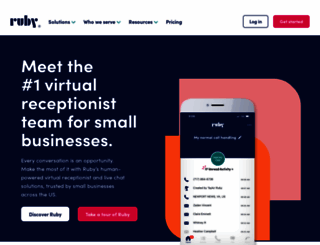Ruby: #1 Virtual Receptionist & Live Chat Solution for Small Businesses
Page Load Speed
1.6 sec in total
First Response
142 ms
Resources Loaded
1 sec
Page Rendered
459 ms

About Website
Click here to check amazing Ruby content for United States. Otherwise, check out these important facts you probably never knew about ruby.com
14,000+ small businesses trust the virtual receptionists at Ruby to create meaningful connections over the phone and through live chat, 24/7.
Visit ruby.comKey Findings
We analyzed Ruby.com page load time and found that the first response time was 142 ms and then it took 1.5 sec to load all DOM resources and completely render a web page. This is quite a good result, as only 30% of websites can load faster.